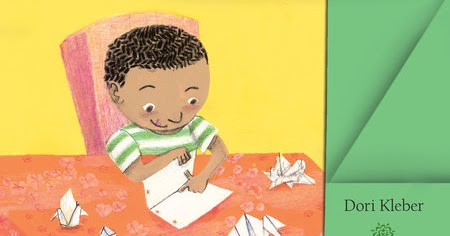

But when he folded up all thirty-eight dollars in his mom’s purse, she put her foot down. When he ran out of notebook paper and construction paper, he used his homework…the newspaper…his sister’s sheet music…gift wrap… even “Aunt Vivian’s pineapple surprise” recipe card. Joey raced home that afternoon and began folding. Takimoto answered that while she could teach him the right folds, it would take practice and patience to become an origami master.

“‘I want to make origami,’” Joey told Sarah’s mother. Takimoto called it origami.” Joey was smitten. Sarah Takimoto’s mother came to his class, and-right before the students’ eyes-folded, flipped, and pulled a plain white piece of paper “until it became…a crane.” One day Joey witnessed the most amazing thing at school. At home he had a collection of “old road maps,” the bellows on an accordion made it his favorite instrument, and he even tucked himself into a foldaway bed at night. Joey was a little boy with a particular fascination.

More-igami Written by Dori Kleber | Illustrated by G. Visit OrigamiUSA for more information and lots of templates to download and follow.

To celebrate today’s holiday create some origami figures of your own. World Origami Days are held from October 24-which commemorates the birthday of Lillian Oppenheimer, the founder of the first American origami group and instrumental in the founding of the British Origami Society and Origami USA-to November 11, which is Origami Day in Japan. Once primarily used at ceremonies and special events, origami is now enjoyed by people of all ages around the globe. Yogibrarian is licensed under a Creative Commons Attribution-NonCommercial-ShareAlike 4.0 International License.The art of paper folding known as Origami is enjoyed around the world and has it’s roots in paper craft traditions of Europe, China, and Japan. I displayed a couple of our easy origami books for kids to choose from. I liked the addition of the craft sticks from this post. Our first station was a paper fan station like they mention in the book. I set up four stations with origami activities ranging from easiest to most challenging. Read More-igami by Dori Kelber and illustrated by G. We could sit with legs straight out to look like an “L.” We could do a downward dog twist to look like the letter “A.” I then talked about folding paper to look like other objects we see. I talked about how we can fold our bodies to look like things. One kid said you could fold a pizza, but he didn’t like to eat his like that. They gave me examples like folding paper, folding clothes, and folding sheets.


 0 kommentar(er)
0 kommentar(er)
